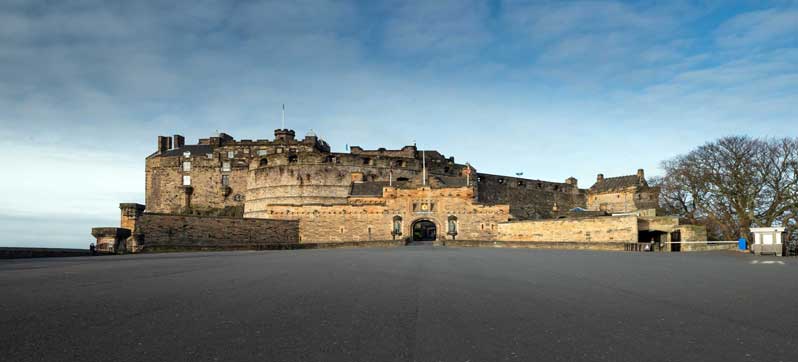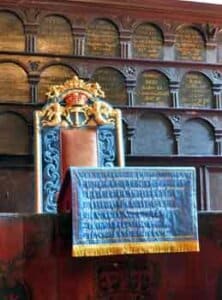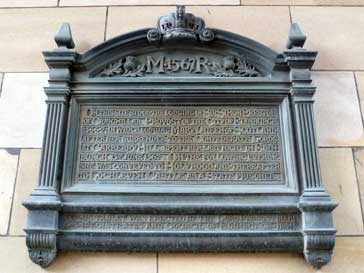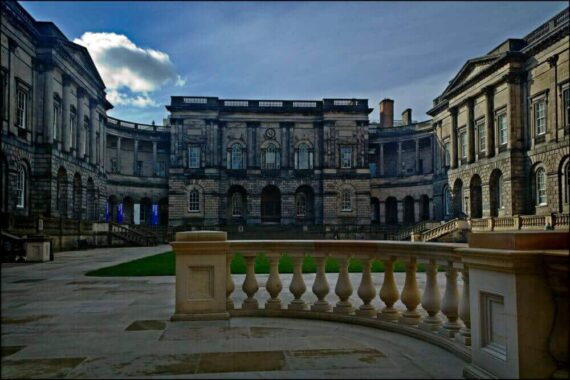
Edinburgh Castle
Discover seven notable 16th century events in Edinburgh, each one contributing to the fascinating history of Scotland’s capital city.
Edinburgh events during the 1500s
The 16th century in Edinburgh was a period of significant change and upheaval.
During the period, as Scotland grappled with the Reformation, Edinburgh emerged as a focal point of religious strife and reform which shifted the country from Catholicism to Protestantism.
The city’s fortifications were also modernised to defend against potential threats, reflecting the turbulent political climate of the time.
Mary, Queen of Scots’ return in 1561 added to 16th century Edinburgh’s dynamic history.
The establishment of the University of Edinburgh in 1583, signalled a burgeoning focus on education and intellectual growth, while the frequent outbreaks of plague underscored the harsh realities of city life,
Although each 16th century event in Edinburgh is listed individually, some of them are interconnected. Together they are designed to encourage the reader to find out more.
Each entry has a link to further information on Truly Edinburgh or other authoritative source.
1) Magdalen Chapel built (1541 – 1544)
The Magdalen Chapel, located on Cowgate in Edinburgh’s Old Town, was built between 1541 and 1544.
It was the last Roman Catholic chapel to be built in the city before the Scottish Reformation of 1560.
It was funded by Michael Macquhane (MacQueen), a merchant who bequeathed money for its construction, and his widow, Jonet (Janet) Rynd, who ensured the project’s completion.

Deacon’s Chair: Magdalene Chapel
The chapel was designed to accommodate a chaplain and serve as an almshouse for seven poor men who would pray for the soul of Mary, Queen of Scots.
It also hosted academic lectures before the Reformation organised by Mary of Guise, mother of Mary Queen of Scots who felt that young men should study. It was a similar model to one founded in France in the 1530s.
At one point it was regularly used by the Incorporation of Hammermen as as their convening hall. Today the Magdalen Chapel is owned by the Scottish Reformation Society
- More information about Magdalen Chapel from Truly Edinburgh.
2) Earl of Hertford’s attack on Edinburgh (1544)
In May 1544, the Earl of Hertford, brother to Henry VIII’s third wife Jane Seymour, led an English army in a devastating attack on Edinburgh during a historical period known as the Rough Wooing.
The English forces, with orders to “burn Edinburgh town” and leave it “so razed and defaced” as a perpetual reminder of God’s vengeance, successfully captured and sacked the city of Leith before moving on to Edinburgh.
The town was set ablaze on May 7, 1544, causing widespread destruction and chaos.
Despite the extensive damage, the Scottish artillery within Edinburgh Castle managed to harass the English forces, preventing them from fully besieging the castle.
After less than two weeks of harrying the Scottish capital, Hertford’s forces withdrew, leaving behind a city in ruins but with its castle still defiantly standing.
“Edinburgh 1544 – the first digital reconstruction of the Scottish capital in the early sixteenth century.”
The reconstruction was created by Smart History, a spin-out company from the University of St Andrews. For anybody interested in the history of Edinburgh, particularly in the 16th century, this project is essential reading
3) Mary Queen of Scots returns to Scotland from France to claim her kingdom (1561)
On August 19, 1561, Mary, Queen of Scots, returned to Scotland from France following the death of her husband, King Francis II of France.
Her arrival in Leith marked the beginning of a tumultuous period in Scottish history, as she sought to assert her claim to the Scottish throne.
Despite her Catholic faith and the Protestant Reformation’s growing influence in Scotland, Mary’s return was met with a mix of enthusiasm and apprehension from the Scottish nobility and populace.
Mary’s return was celebrated with a grand royal entry into Edinburgh on September 2, 1561.
The event was marked by elaborate pageantry and festivities, showcasing the young queen’s status and the hope for stability under her reign.

However, Mary faced significant challenges, including religious conflicts and political intrigue, which ultimately led to her forced abdication and imprisonment.
Her return to Scotland remains a pivotal moment in the country’s history, highlighting the complexities of her reign and the broader religious and political landscape of the time.
4) University of Edinburgh established (1583)
A royal charter, the ratification and extension of a previous charter from Mary Queen of Scots, signed by James VI led to the opening of The University of Edinburgh in October 1583.
It’s the sixth oldest university in the English-speaking world.
Initially known as Tounis College, it was established with the support of the Town Council and a legacy left by Robert Reid, Bishop of Orkney.

University of Edinburgh: Old College
The university quickly became a hub of intellectual activity, playing a pivotal role in the Scottish Enlightenment and producing notable alumni such as philosopher David Hume and chemist Joseph Black, both influential thinkers during the Scottish Enlightenment.
The university’s alumni also includes Charles Darwin, who studied medicine there before embarking on his groundbreaking work in evolutionary biology.
Over the centuries, the University of Edinburgh has expanded its campus and academic offerings, becoming a world-renowned institution
With a large student body and a global reputation for excellence in research and education, the university continues to influence history and society
Its commitment to innovation and critical thinking has cemented its status as a leading academic institution, contributing significantly to the intellectual and cultural heritage of Edinburgh and beyond.
- More information about the foundation of the University of Edinburgh from Truly Edinburgh.
5) Lauriston Castle, Edinburgh built (1593)
Lauriston Castle, located in the Cramond area of Edinburgh, was built around 1593 by Archibald Napier, 7th Laird of Merchiston. It’s a blend of 16th-century tower house and 19th-century luxury mansion.
Situated on a picturesque estate overlooking the Firth of Forth, the castle has beautiful parkland and forest walks, including an award-winning Japanese garden. Throughout its history, Lauriston Castle has witnessed numerous changes and restorations, reflecting the evolving tastes and needs of its occupants.
The castle, now under the care of the City of Edinburgh Council, offers guided tours showcasing its rich history and elegant Edwardian interiors. With its combination of historical architecture and beautiful natural surroundings, Lauriston Castle remains a much-loved visitor attraction.
More information about Lauriston Castle from Truly Edinburgh.
6) The Treaty of Edinburgh (1560)
The Treaty of Edinburgh, signed on July 5, 1560, marked a significant turning point in Scottish history, aiming to end the Siege of Leith and replacing the Auld Alliance between Scotland and France with a new Anglo-Scottish accord.
Negotiated between Queen Elizabeth I’s Commissioners and the Scottish Lords of the Congregation, with French representatives of King Francis II, the treaty resulted in the withdrawal of French and English troops from Scotland.
This allowed Scotland to settle its own affairs, paving the way for the Scottish Reformation. With foreign troops gone, Scottish Protestants established Protestantism as the national religion. That reshaped Scotland’s religious landscape and prepared the groundwork for its future political and social development.
- Truly Edinburgh looks at some of the events that led to the signing of the Treaty of Edinburgh.
7) Building of the Flodden Wall in Edinburgh (c.1513)
The Flodden Wall, built following the disastrous Battle of Flodden in 1513, was a significant defensive structure constructed to protect 16th century Edinburgh from potential invasions.
Much has been written by the Scot’s defeat and the death of its king at the hands of Thomas Howard, Earl of Surrey on behalf of Henry VIII.
“When dawn broke on the morning of 10th September, 1513, the landscape of
The Standing Council of Scottish Chiefs
hell was revealed.”
Named after the battle, the wall was part of a broader effort to fortify the city and ensure its safety from future English attacks.
The construction began shortly after the battle and continued over several decades, resulting in a robust fortification that encircled much of Edinburgh. It included some sections of existing town walls.
Although the wall was clearly defensive in intent, Historic Environment Scotland say, ” it also defined the legal limit of the medieval burgh in the early 16th century, and would have controlled the passage of people, goods and animals into and out of the burgh.”
As such it served to secure the payment of custom dues, deter smuggling and stop the spread of disease.
Although much of the Flodden Wall has been demolished over the centuries, several sections still stand today, offering a glimpse into Edinburgh’s medieval past.
These remnants can be seen in various parts of the city, including the Grassmarket and Greyfriars Kirkyard.
The wall’s historical significance and its role in Edinburgh’s defensive strategy make it an intriguing piece of the city’s heritage.
- More information about the Flodden Wall from Historic Environment Scotland.
16th century events in Edinburgh: conclusion
Edinburgh underwent a profound transformation in the 16th century, influenced by pivotal events that played an important role in shaping the city’s future identity.
16th century Edinburgh: suggestions for further research & reading
- Harrison, A. and Burnett, C.J., 2018, November. Scottish Lettering of the 16th century. In Proceedings of the Society of Antiquaries of Scotland (Vol. 147, pp. 219-241).
- Edwards, B. ed., 2019. Edinburgh-The Making of a Capital City. Edinburgh University Press.
- Grant, J., 1884. Cassell’s old and new Edinburgh (Vol. 3).
- O’Brien, I.E., 1980. The Scottish Parliament in the 15th and 16th centuries (Doctoral dissertation, University of Glasgow).
17th century Edinburgh
- Read 17th century events in Edinburgh on Truly Edinburgh